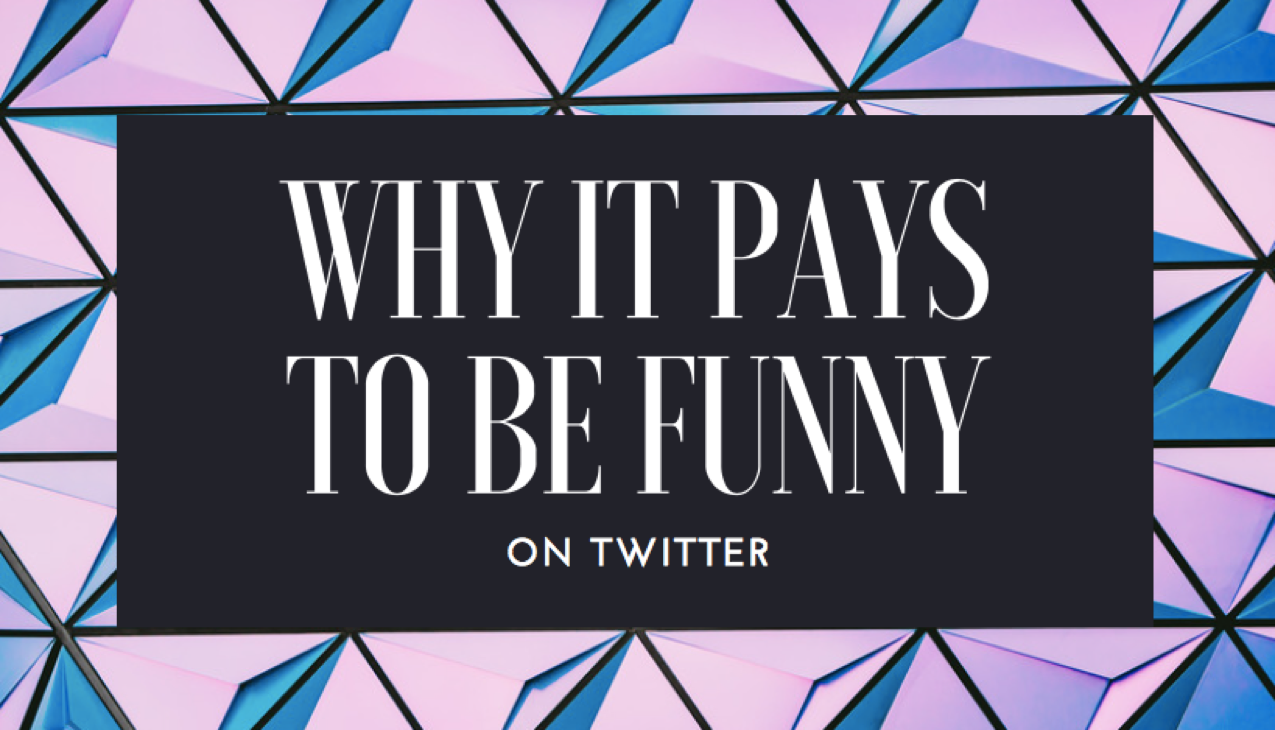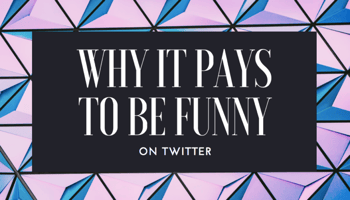



 How does a small flower shop in the UK get 35,000 followers on Twitter? Hint: it’s not by tweeting about flowers.
How does a small flower shop in the UK get 35,000 followers on Twitter? Hint: it’s not by tweeting about flowers.
5 years ago, the owners at Arena Flowers decided to get in on joke Twitter despite the fact that they're the last type of company you'd think of as a comedy brand. In all my training with marketing and writing, I constantly look back on it as a pivotal moment of sheer social media marketing genius.
Let’s talk about Arena Flowers, a few other companies who are doing the funny thing on Twitter, what they’re doing right, and how you can start getting attention and laughs for your own brand.
These companies have jokes, but here’s the other cool thing about them: almost all of their tweets are funny, silly, meme-y, and stream-of-consciousness. No promo messaging here (or at least only a very tiny bit of it).
6 hours since Big Ben fell silent. No one knows what time it is. The BBC's best guess is 1872. Dinosaurs spotted in Ipswich. Chaos reigns.
— Arena Flowers (@ArenaFlowers) August 21, 2017
Arena Flowers was one of the first in this modern-day alternative marketing movement.
Think dark, smart, odd, stream-of-consciousness, and existential joke writing, and you’ve got the voice behind the Arena Flowers Twitter account—a voice that is actually a hired team of freelancers who specializes in creating social media content.
Chief Executive Will Wynne explains the process behind deciding to use Twitter as an alternative comedy act: the folks at Arena Flowers realized that 1) no one engages with tweets about flowers; 2) no one follows a service they’ll use maybe twice a year; and 3) they’ll have to find a way—other than talking about flowers—to attract followers.
And so the curated Twitter timeline of comedy gold @ArenaFlowers began.
Don't forget to put your clocks forward before bed tonight. Here's how: pic.twitter.com/MKUYgAhq1b
— innocent drinks (@innocent) March 25, 2017
Innocent Drinks does tweet some promotional stuff, but most of their timeline is dedicated to comedy.
The comedy here is a little different: it’s light, cute, a little wacky, and is often accompanied by little infographics or funny mock Photoshop jobs of Innocent juices disguised as Apple ads.
The use of photos—whether they’re sharing memes made in-house, photos from around the internet, or snapshots of pets around the office—is a brilliant strategy in itself. Memes and delightful photos are the currency of entertainment on the internet, and if you can be the source of those photos for people, you’ve got their attention and engagement.
The comedy Twitter fad is catching on. Shortly after Arena Flowers’ explosion of success, lots of corporate players found their way into the joke Twitter game, with big brands like Wendy’s, Old Spice, and Charmin’ spitting joke game.
The catch-22 about this, though, is that these Twitter timelines often feel very contrived. It feels like a rushed, quantity-over-quality, unoriginal version of Arena Flowers’ original model. Now that big brands know that funny works, they’re taking over funny in ways that don’t feel all that genuine anymore.
Except for DiGiorno, that is. They’re actually kind of nailing it. Far from campy and contrived, DiGiorno is the biggest brand on this list, which shows you don’t have to work with a brand as small as a UK flower company to pull this off.
johnny manziel looks like someone waiting for a delivery pizza that will never arrive #DraftDay2014
— DiGiorno Pizza (@DiGiornoPizza) May 9, 2014
Seriously, they’re genius.
There’s so much marketing genius going on here that I could write a whole series on it, but to help get you started in the right direction if you're thinking about using humor in marketing, let’s cover the few main reasons why this strategy works so well.
They’re making an impression on you.
By making you laugh, they're making themselves memorable as heck.
Oh, and they're not just making an impression on you—when you send your friend the funny graphic on Daylight Savings Time tweeted by Innocent Drinks, they’re making an impression on your friend, too.
If you can get your customers to laugh—and share your stuff, and get more people laughing, and just plain delight other people with your brand personality—you’re golden.
They don’t make you feel like you’re being marketed to.
You’re not being sold to, you’re being invited in on a joke. That’s the beautiful thing about marketing with comedy.
In an interview with Audiense, Communities Manager Helena Langdon explains the strategy behind the lovably honest and fun Innocent Twitter account: “We want to tell people about us in the most engaging way we can. It’s our goal to make our pages a place on social media where people want to visit and enjoy seeing in their timelines, then people won’t mind when we try to sell them drinks every now and again.”
Imagine that—a company that wants to build a relationship with you first, then sell. Isn’t that the kind of marketing we can all feel good about?
They’re only being funny when it’s appropriate to do so.
Arena Flowers consciously abstains from tweeting right after Mother’s Day or Valentine’s Day. Why? “…we go quiet for a couple of days because if something has gone wrong for someone and you’re being funny and glib you set yourself as a bit of a target,” Will Wynne says.
They also don’t tweet when they’re working through big customer service issues.
Basically, they know how to tweet with tact. Pressing pause on the funny tweets when you or your customers are working through a difficult time shows you’re not just a heartless goof-off: you may know how to make jokes on Twitter, but you’re reassuring them that you take them and their concerns 100% seriously.
They’re reminding us that they’re all human.
I don’t care WHAT brand I get a tweet from—even if it’s Charmin (who I just called kind of phony above), I’m gonna get pumped. It’s cool, right? To see a tweet from DiGiorno or Old Spice or Wendy’s that makes you go, “Oh, right, an actual person is writing these”?
And in a world run by faceless brand names, we desperately need this. While I may not love the corporate brand of Wendy’s as a whole, I love interacting with actual people who are funny, kind, caring, and who also happen to work at Wendy’s.
Does this sound like something you and your marketing team can rally behind? If you’re struggling to gain traction on Twitter and the standard “Check out our new product thing!” tweets aren’t really panning out—well, why not?
The only reasons you shouldn’t are if 1) you’re in a sensitive industry, like funeral services, law, or medical; or 2) you often have major customer support issues.
If that’s not you, you should totally try it out. The stakes are low because it’s not a forever decision; if you find it doesn’t quite pan out for you, you can simply go back to your regular tweet programming.
Your funny tweets, that is.
Joke Twitter (or Weird Twitter) definitely has its own unwritten rules of etiquette, and breaking those rules makes you look campy, hacky, or desperate. So think about that when you’re deciding who will write your jokes for you: Steve in marketing who thinks Two and a Half Men is the funniest thing he’s ever seen and cries laughing at Dilbert comics, or someone who’s written and participated in the comedy community on Twitter for years?
It’s obvious what I personally think the wiser call is, but if you can’t afford to hire outside help right now, don’t fret. Everyone starts out as the new kid on the block on Joke Twitter, and you can, too. Get started now (perhaps on a personal account), get practicing, and see if you can pick up the skills you’ll need to DIY this alternative marketing method.
Oh, and you might want to pick up a few joke-writing books next time you’re out and about.
But make ‘em loose and light. That’s the only way the genuineness and creative magic of this kind of comedy can shine through. On a minimal level, you should address whether or not slang is okay and what kind of topics or language are off-limits.
But other than that, what kind of funny do you want to be? Dark and existential like Arena Flowers, or light and silly like Innocent Drinks? Will you focus on text-based tweets, or throw in some homemade graphics? Or—if you’re not sure—why not just have your writer have fun with it and see if you grow into a style organically? That sounds genuine as heck.
Aim and fire.
Hit that send button. And then measure. What do your Twitter Analytics look like now? It could be fun to compare your success after 6 months compared to a benchmark of when you first started: what happens when you switch from mostly marketing-based tweets to mostly joy-spreading tweets?
Does the idea of alternative marketing kind of freak you out, or do you think you’ll give it a shot? How would you rather be marketed to: with traditional marketing messaging, or with personality and humor? Let us know in the comments below!


Spot On co-founder and partner Susie Kelley is dedicated to leveraging technology to advance innovative solutions in highly regulated industries. Driven by the opportunity to elevate brands, she co-founded Spot On in 2012 after having spent 15 years honing her marketing skills in an agency. Susie leads business development with a personal touch, focusing on building lasting relationships with clients to meet — and exceed — their goals for business growth.
Get the latest and greatest posts sent straight to your inbox.


